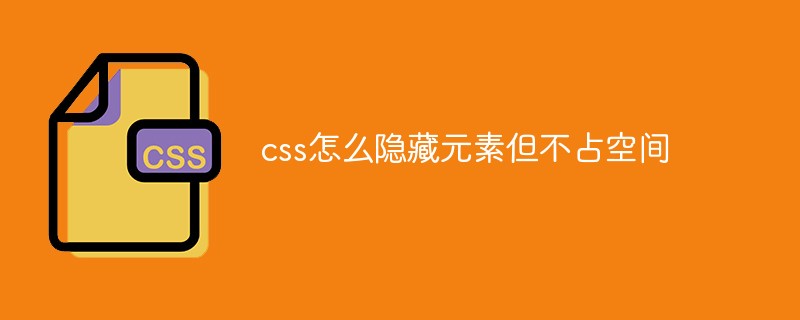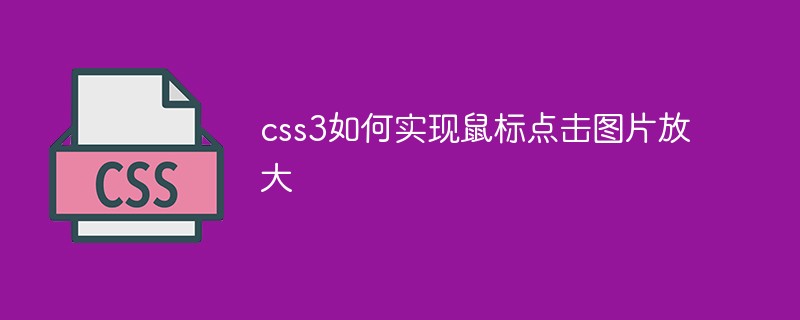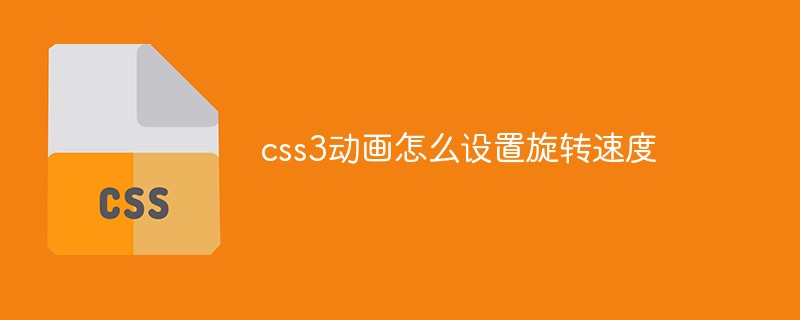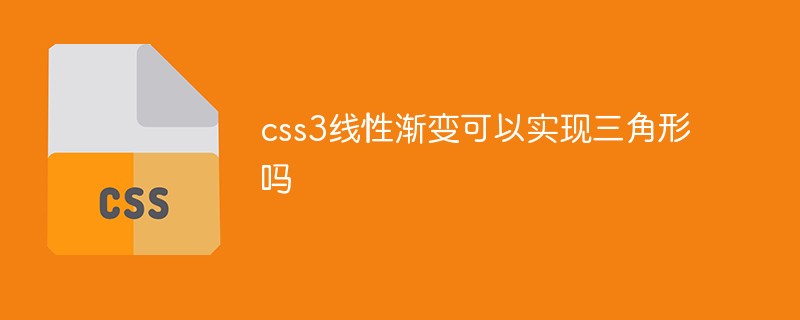CSS3 is an upgraded version of CSS technology. Elements in the CSS3 specification can develop at different speeds because different browser manufacturers only support given features. HTML5 is the fifth major revised version of HTML. It is the specification of HTML, the core language in the Web, and a language description method for constructing Web content.

The operating environment of this tutorial: Windows 7 system, CSS3&&HTML5 version, Dell G3 computer.
What is CSS3?
CSS is the abbreviation of Cascading Style Sheets (Cascading Style Sheets). It is an application used to express HTML (Standard Generalized Markup Language) or XML (Standard Generalized Markup Language). A subset) of other file-style computer languages.
CSS can perform pixel-level precise control over the layout of element positions in web pages, supports almost all font size styles, and has the ability to edit web page objects and model styles.
CSS3 is an upgraded version of CSS (Cascading Style Sheet) technology. It was formulated in 1999. On May 23, 2001, W3C completed the working draft of CSS3, which mainly includes box model, list module and hyperlink method. , language module, background and border, text effects, multi-column layout and other modules.
One of the major changes in the evolution of CSS is the W3C's decision to break CSS3 into a series of modules. Browser vendors innovate quickly at the pace of CSS, so by taking a modular approach, elements in the CSS3 specification can move forward at different speeds because different browser vendors only support given features. But different browsers support different features at different times, which also complicates cross-browser development.
The principle of CSS3 is the same as that of CSS. It is to customize the selectors of the style sheet in the web page, and then reference these selectors in large numbers in the web page.
What is HTML5?
HTML5 is a revised version of Hypertext Markup Language (HTML), the fifth major revision; HTML is a standard programming language used to describe the content and appearance of web pages. HTML5 supports traditional HTML and XHTML style syntax along with other new features in its markup, new API, XHTML and error handling.
HTML5 is a language description method for constructing web content. HTML5 is the next generation standard of the Internet and a language method for constructing and presenting Internet content. It is considered to be one of the core technologies of the Internet. HTML was created in 1990, and HTML4 became an Internet standard in 1997 and is widely used in the development of Internet applications.
HTML5 is the specification of the core language HTML in the Web. The content that users see when browsing the web using any means is originally in HTML format. It is converted into a recognizable format through some technical processing in the browser. Information. HTML5 has made certain improvements on the basis of the previous HTML4.01. Although technical personnel may not put these new technologies into application during the development process, website development technical personnel must be aware of the new features of this technology. understand.
HTML5 was developed to resolve compatibility issues affecting the current standard HTML4. One of the biggest differences between HTML5 and previous versions of the standard is that older versions of HTML required proprietary plug-ins and APIs. (This is why a web page built and tested in one browser may not load correctly in another browser.) HTML5 provides a common interface that makes loading elements easier. For example, there is no need to install the Flash plugin in HTML5 as the element will run on its own.
The purpose of HTML5 is primarily to make it easier for web developers and browser creators to follow consensus-based standards, thereby improving compliance and enhancing compliance. It is also designed to provide a better, faster, and more consistent user experience for desktop and mobile visitors.
One of the design goals of HTML5 is to support multimedia on mobile devices. New syntax features have been introduced to support this functionality, such as video, audio and canvas tags. HTML5 also introduces new features that can truly change the way users interact with documents.
Note:
HTML5 and CSS3 are not only two new Web technology standards, but also represent the next generation of HTML and CSS technologies. Although the standard specification of HTML5 has not been officially released, the future development prospects are already foreseeable, that is, HTML5 will be used by more and more web developers. Major mainstream browser manufacturers have actively updated their products to Better support for HTML5.
HTML5 revolves around one core: building a more powerful web application development platform.
1) More descriptive tags: HTML5 introduces a lot of descriptive tags, such as for defining header, footer, navigation area (nav), sidebar (aside) ) and other tags make it very convenient for developers to build page elements.
2) Good multimedia support: For the previous troubles caused by playing audio and video through plug-ins, HTML5 has a solution. The audio tag and video tag can easily implement the response.
3) More powerful web applications: HTML5 provides amazing features, and in some cases, you can even give up using third-party technologies entirely.
4) Cross-document message communication: Web browsers will organize script interactions or influences between different domains, but this may be troublesome for trusted scripts. HTML5 introduces a set of safe and easy-to-implement solutions.
5) Web Sockets: HTML5 provides support for Web Sockets.
6) Client-side storage: HTML5's Web Storage and Web SQL Database API can build client-side persistent data for web applications in the browser.
7) More exquisite interface: The interface effect rendered by HTML5 CSS3 combination is sometimes unimaginably exquisite.
8) More powerful forms: HTML5 provides more powerful form interface controls, which are very convenient to use.
9) Improve accessibility: The content is clearer, making the user's operation easier and more convenient, and improving the experience.
10) Advanced selector: CSS3 selector can easily identify odd and even rows, check boxes, etc. of the table with fewer code marks.
11) Visual effects: part of the exquisite interface, visual effects such as shadows, gradients, rounded corners, rotation, etc.
For some browsers that do not fully support HTML5, HTML5 can easily add code that is compatible with adaptive alternative solutions to the code. After writing the HTML5 code, you can verify it with the W3C verification service (relatively, because the HTML5 standard is still evolving).
Related recommendations: "html video tutorial"
The above is the detailed content of What is css3 and HTML5. For more information, please follow other related articles on the PHP Chinese website!
 css怎么隐藏元素但不占空间Jun 01, 2022 pm 07:15 PM
css怎么隐藏元素但不占空间Jun 01, 2022 pm 07:15 PM两种方法:1、利用display属性,只需给元素添加“display:none;”样式即可。2、利用position和top属性设置元素绝对定位来隐藏元素,只需给元素添加“position:absolute;top:-9999px;”样式。
 原来利用纯CSS也能实现文字轮播与图片轮播!Jun 10, 2022 pm 01:00 PM
原来利用纯CSS也能实现文字轮播与图片轮播!Jun 10, 2022 pm 01:00 PM怎么制作文字轮播与图片轮播?大家第一想到的是不是利用js,其实利用纯CSS也能实现文字轮播与图片轮播,下面来看看实现方法,希望对大家有所帮助!
 css3如何实现鼠标点击图片放大Apr 25, 2022 pm 04:52 PM
css3如何实现鼠标点击图片放大Apr 25, 2022 pm 04:52 PM实现方法:1、使用“:active”选择器选中鼠标点击图片的状态;2、使用transform属性和scale()函数实现图片放大效果,语法“img:active {transform: scale(x轴放大倍数,y轴放大倍数);}”。
 css3什么是自适应布局Jun 02, 2022 pm 12:05 PM
css3什么是自适应布局Jun 02, 2022 pm 12:05 PM自适应布局又称“响应式布局”,是指可以自动识别屏幕宽度、并做出相应调整的网页布局;这样的网页能够兼容多个不同的终端,而不是为每个终端做一个特定的版本。自适应布局是为解决移动端浏览网页而诞生的,能够为使用不同终端的用户提供很好的用户体验。
 css3动画效果有变形吗Apr 28, 2022 pm 02:20 PM
css3动画效果有变形吗Apr 28, 2022 pm 02:20 PMcss3中的动画效果有变形;可以利用“animation:动画属性 @keyframes ..{..{transform:变形属性}}”实现变形动画效果,animation属性用于设置动画样式,transform属性用于设置变形样式。
 css3怎么设置动画旋转速度Apr 28, 2022 pm 04:32 PM
css3怎么设置动画旋转速度Apr 28, 2022 pm 04:32 PM在css3中,可以利用“animation-timing-function”属性设置动画旋转速度,该属性用于指定动画将如何完成一个周期,设置动画的速度曲线,语法为“元素{animation-timing-function:速度属性值;}”。
 css3线性渐变可以实现三角形吗Apr 25, 2022 pm 02:47 PM
css3线性渐变可以实现三角形吗Apr 25, 2022 pm 02:47 PMcss3线性渐变可以实现三角形;只需创建一个45度的线性渐变,设置渐变色为两种固定颜色,一个是三角形的颜色,另一个为透明色即可,语法“linear-gradient(45deg,颜色值,颜色值 50%,透明色 50%,透明色 100%)”。
 一文了解CSS3中的新特性 ::target-text 选择器Apr 12, 2022 am 11:24 AM
一文了解CSS3中的新特性 ::target-text 选择器Apr 12, 2022 am 11:24 AM本篇文章带大家一起深入了解一下CSS3中的新特性::target-text 选择器,聊聊该选择器的作用和使用方法,希望对大家有所帮助!


Hot AI Tools

Undresser.AI Undress
AI-powered app for creating realistic nude photos

AI Clothes Remover
Online AI tool for removing clothes from photos.

Undress AI Tool
Undress images for free

Clothoff.io
AI clothes remover

AI Hentai Generator
Generate AI Hentai for free.

Hot Article

Hot Tools

Dreamweaver Mac version
Visual web development tools

VSCode Windows 64-bit Download
A free and powerful IDE editor launched by Microsoft

MinGW - Minimalist GNU for Windows
This project is in the process of being migrated to osdn.net/projects/mingw, you can continue to follow us there. MinGW: A native Windows port of the GNU Compiler Collection (GCC), freely distributable import libraries and header files for building native Windows applications; includes extensions to the MSVC runtime to support C99 functionality. All MinGW software can run on 64-bit Windows platforms.

PhpStorm Mac version
The latest (2018.2.1) professional PHP integrated development tool

SAP NetWeaver Server Adapter for Eclipse
Integrate Eclipse with SAP NetWeaver application server.






